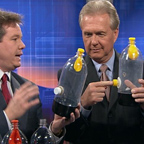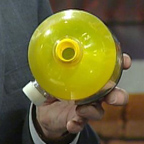Of all the natural processes around us, the annual changing of leaves from green to different shades of yellow, orange, and red is perhaps the most beautiful. But behind this show of color, there are important scientific processes at work.
Want a peek into the science behind a tree's changing leaves? With this hands-on activity, you'll see how those colors stay hidden in the leaf all year long!
Want a peek into the science behind a tree's changing leaves? With this hands-on activity, you'll see how those colors stay hidden in the leaf all year long!
What You Need:
- Leaves
- small jar (a baby food or small salsa jars work well)
- cover for jars or aluminum foil or plastic wrap
- rubbing alcohol
- paper coffee filter
- shallow pan
- hot tap water
- plastic knife or spoon
1) Have your child collect 2-3 large leaves from the same tree type. You and your child should tear or chop the leaves into very small pieces and put them into small jars.
2) Add enough rubbing alcohol to the jar to cover the leaves. Using a plastic knife or spoon, carefully chop and grind the leaves in the alcohol.
SAFETY NOTE: rubbing alcohol can be harmful if mishandled or misused. Use in a well-ventilated area, and avoid contact with skin.
3) Have your child cover the jar very loosely with a lid, plastic wrap or aluminum foil. Place the jar carefully into a shallow tray containing 1 inch of hot tap water.
4) Keep the jar in the water for at least a half-hour, longer if needed, until the alcohol has become colored (the darker the better).
Twirl the jar gently about every five minutes. Replace the hot water if it cools off.
5) Have your child cut a long thin strip of coffee filter paper.
Remove the jar from the water and uncover it. Place a strip of filter paper into the jar so that one end is in the alcohol. Bend the other end over the top of the jar and secure it with tape.
The alcohol will travel up the paper, bringing the colors with it.
6) After 30-90 minutes the colors will travel different distances up the paper as the alcohol evaporates. You should be able to see different shades of green, and possibly some yellow, orange or red, depending on the type of leaf.
What happened?
Chlorophyll is a green compound that hides the other colored pigments present in leaves. In the autumn chlorophyll breaks down, allowing the other pigments to be seen. The mix of pigments in a leaf may be separated into bands of color by the technique of paper chromatography.Chromatography involves the separation of mixtures into individual components, which you just did using alcohol and energy (heat). Then, by "absorption" and "capillarity," separation can take place!
The paper holds the substances using absorption, while capillarity pulls the substances up the paper at different rates. Pigments are separated on the paper and show up as colored streaks or bands.
Pretty cool, huh?
As possible extension activities compare different types of leaves and/or experiment with other types of paper.
Mike is a 20-year veteran science teacher, and runs an online business (www.scienceinabag.com). Over the years Mike has studied trends in science, education, and finance, conducting research, developing programs, and writing articles on these topics.
SOURCE: Education.com
LAGNIAPPE: Chlorophyll in Olive Oil






























 The balloon won't inflate much the first time because the bottle is already filled with air. There's no room for the balloon to expand inside the bottle. However, when you punch a hole in the bottle, the air molecules in the bottle have an exit. They're pushed out as the balloon fills the space inside. As long as you plug the hole, the balloon stays inflated.
The balloon won't inflate much the first time because the bottle is already filled with air. There's no room for the balloon to expand inside the bottle. However, when you punch a hole in the bottle, the air molecules in the bottle have an exit. They're pushed out as the balloon fills the space inside. As long as you plug the hole, the balloon stays inflated. Try this! Inflate the balloon in the bottle again and cover the nail hole with your thumb. Pour water into the balloon while keeping your thumb over the hole. Go outside or hold the bottle over a sink before you remove your thumb. Watch out for that stream of water gushing out of the bottle top! You might decide to hand a full water-balloon-bottle to a friend and just "forget" to tell them about the hole.
Try this! Inflate the balloon in the bottle again and cover the nail hole with your thumb. Pour water into the balloon while keeping your thumb over the hole. Go outside or hold the bottle over a sink before you remove your thumb. Watch out for that stream of water gushing out of the bottle top! You might decide to hand a full water-balloon-bottle to a friend and just "forget" to tell them about the hole.